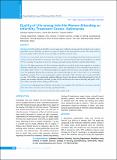Please use this identifier to cite or link to this item:
https://hdl.handle.net/20.500.14356/1269Full metadata record
| DC Field | Value | Language |
|---|---|---|
| dc.contributor.author | Shrestha, Subhadra Pradhan | - |
| dc.contributor.author | Bhandari, Sushila Devi | - |
| dc.contributor.author | Pradhan, Sushaili | - |
| dc.date.accessioned | 2023-05-04T06:50:23Z | - |
| dc.date.available | 2023-05-04T06:50:23Z | - |
| dc.date.issued | 2020 | - |
| dc.identifier.citation | Pradhan ShresthaS., BhandariS. D., & PradhanS. (2020). Quality of Life among Infertile Women Attending an Infertility Treatment Center, Kathmandu . Journal of Nepal Health Research Council, 18(3), 394-400. https://doi.org/10.33314/jnhrc.v18i3.2639 | en_US |
| dc.identifier.issn | Print ISSN: 1727-5482; Online ISSN: 1999-6217 | - |
| dc.identifier.uri | http://103.69.126.140:8080/handle/20.500.14356/1269 | - |
| dc.description | Original Article | en_US |
| dc.description.abstract | Abstract Background: The problem of infertility is an increasing issue worldwide, among married reproductive age couples, particularly women. Infertility can affect every aspect of quality of life among infertile women. This study aimed to assess the quality of life of infertile women attending an infertility treatment center. Methods: A crossectional study of 385 infertile women age 25-50 years attending an infertility treatment center was carried out from 8th July 2018 to 4th January 2019. Data were collected using the Short Form Health Survey (Rand SF-36), containing 36 questions by interview technique and analyzed using descriptive and inferential statistics. Results: The higher proportion (63.38%) of primary infertility was involved in this study compared to secondary infertility without baby (24.93%) and with the baby (11.69%). More than half (54.5%) of infertile women had low-level quality of life whereas 45.5% of them had a high level of quality of life. The mean scores of quality of life subscales were not significantly different between primary and secondary infertility (p-value >0.05). There was no statistically significant association between socio-demographic variables and quality of life of primary and secondary infertility (p-value >0.05). There was a statistically significant difference between the duration of infertility and quality of life of primary and secondary infertility with baby (p-value 0.020), and between the reason of infertility and quality of life of secondary infertility without a baby (p-value 0.010). Conclusions: A high proportion of infertile women had low-level quality of life. Therefore, it is necessary to provide them information, education, and counseling regarding infertility. Keywords: Infertility treatment center; infertile women; quality of life | en_US |
| dc.language.iso | en | en_US |
| dc.publisher | Nepal Health Research Council | en_US |
| dc.relation.ispartofseries | Jul-Sep 2020; | - |
| dc.subject | Infertility treatment center | en_US |
| dc.subject | Infertile women | en_US |
| dc.subject | Quality of life | en_US |
| dc.title | Quality of Life among Infertile Women Attending an Infertility Treatment Center, Kathmandu | en_US |
| dc.type | Journal Article | en_US |
| local.journal.category | Original Article | - |
| Appears in Collections: | Vol. 18 No. 3 (2020): Vol. 18 No. 3 Issue 48 Jul-Sep 2020 | |
Files in This Item:
| File | Description | Size | Format | |
|---|---|---|---|---|
| 2639-Manuscript-18830-2-10-20201118.pdf | Fulltext Article. | 282.79 kB | Adobe PDF |  View/Open |
Items in DSpace are protected by copyright, with all rights reserved, unless otherwise indicated.
